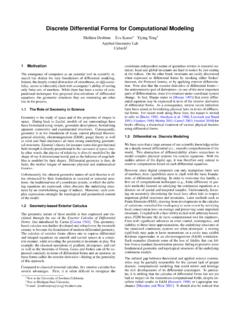Transcription of Work for play - Bureau of Labor Statistics
1 Work for play:Careers in video game developmentFall 2011 Occupational Outlook Quarterly 3 Drew Liming and Dennis VilorioDrew Liming is an economist in the Office of Occupational Statistics and Employment Projections, BLS. He is available at (202) 691-5262 or Vilorio is an economist in the Office of Occupational Statistics and Employment Projections, BLS. He is available at (202) 691-5711 or games aren t only for play; they also provide work. The workers, known as game developers, make a living creating the games you enjoy video games is a serious and big business. According to the Entertain-ment Software Association, in 2009, the video game industry had sales in excess of $10 bil-lion and employed more than 32,000 people in 34 states. Creating these games is complex and requires the collaboration of many developers, who perform a variety of tasks, from produc-tion to programming.
2 They work for both small and large game studios to create games that can be played on many different devices, including console systems, computers, and cell article covers career options in video game development. The first section provides an overview of the development process. The second section describes four groups of video game occupations: designers, programmers, artists, and others. The third section covers the skills and training workers need for these jobs. The fourth section discusses the benefits and challenges of working in the video game industry. And the fifth section provides job-seeking tips for a career in video game devel-opment. Suggested resources for additional information are at the end of the of a video gameThe concept for a video game can come from a variety of sources. Many games start as a new idea for a story or technology the devel-opment team would like to explore.
3 Others come from an established property, such as a novel or film. Still others attempt to perfect a style or formula found in another genre or whatever the impetus for its creation, almost every game follows a similar develop-ment process: preproduction, production, and postproduction. The length of this process is often determined at the beginning of the preproduction phase and depends on a game s size and programming games, such as those made for consoles, have more complex program-ming and, therefore, take longer to develop usually between 18 and 30 months. By com-parison, most games that are played on social media and mobile devices require simpler technology, which results in a quicker devel-opment process of a few completed during preproduction lays the foundation upon which a game is built. In this phase, the lead designers outline a game concept with the help of lead artists and pro-grammers.
4 Lead designers also might select a feature, such as an innovative gameplay element or powerful graphics, that makes the game different design teams flesh out a specific part of the game, such as its mechan-ics and storyline. The designers then compile their ideas in a game design document, which describes the game and its features in this document, programmers create a prototype game. Designers use feedback on the prototype to revise game features. Many game studios also use the prototype to secure financing from publishers, allowing the designers to continue developing the the game receives funding, pro-grammers begin building its technological framework. Meanwhile, artists create concept art, such as character illustrations, that helps designers visualize the game. Completion of the prototype signals the start of the produc-tion phase of the production phase, teams of designers, artists, and programmers use the design docu-ment as a guide to create the game.
5 The teams collaborate to make the most of each other s expertise. Art isn t displayed correctly until an engineer makes it work, and it doesn t work until a designer defines how it should work, says Louis Catanzaro, creative director for BeachCooler Games in Waltham, Occupational Outlook Quarterly Fall 2011 Artists use concept art to create textures, models, and animations for the characters, levels, objects, and environments that will populate the game world. Programmers final-ize the game engine a video game s physics and graphics systems and tools. They also write the code that dictates everything from the game s rules to how its visual elements are displayed on the meet with workers from the other departments to ensure that the game s design document is being followed. Feedback during production helps the designers revise the document as needed for example, to improve a game s mechanics or remove an unfeasible production, developers con-tinually build improved versions of the game.
6 The goal is to add more dimensions to the game, says David Sirlin, lead designer for Sirlin Games in Emeryville, California. That is, to create more content that is better looking within a design that is more refined. At the conclusion of the production phase, the fully playable game includes art, music, and sound effects. This milestone is referred to as content complete. Postproduction and beyondPostproduction focuses on playing the game to test it for errors, called bugs, and on tweaking it to eliminate unwanted quality assurance staff tests the game by playing it and attempting to do things the development staff never considered. As the game testers find bugs, they document the errors and assign them to a programmer, designer, or artist to might also find that parts of the game are inconsistent or imbalanced. Fixing these issues might require tweaks to existing features and with bugs and tweaks can make postproduction time-consuming.
7 The process may take as long as production, especially for more complex games that have bigger a game is released, it is distributed for sale to players. However, the work does not end there. Games often need patches, which are frequent updates that might include bug fixes, tweaks to the game s balance, and new content. And a game s success might persuade the studio to develop an expansion a large content and feature update that usually is sold separately as an addition to the original in video game developmentMaking a video game requires many different workers. Developers have diverse specialties, including game design, programming, and art. Depending on the size of the studio in which they work, developers may have varied roles; smaller studios might have one worker performing multiple tasks, and larger studios might have multiple workers for each developers make the most of their different skills to collaborate on a shared goal: creating the best game are video game dreamers.
8 They imagine almost everything about and in a game. To develop a game, teams of designers write detailed descriptions of their ideas for Video game developers carry a concept from preproduction through 2011 Occupational Outlook Quarterly 5all of its parts, including plot, characters, and gameplay. The teams hold regular meetings and select the best a game is in production, designers work closely with programmers and artists to ensure that their designs are being followed. Designers frequently use scripting languages, a type of programming language that controls applications, to view their ideas within the prototype game. Scripting languages do not require extensive coding and allow design-ers to test various concepts as they arise in gameplay. Then, designers choose the concept they like best. If issues arise during produc-tion, designers might have to go back and edit or review the game design different design teams focus on dif-ferent parts of the game, under the direction of a lead designer.
9 Some designers craft engross-ing plots and characters. Other designers work on the mechanics of the designer. Lead designers collect and organize the design teams ideas into a cohesive game design document. They also manage the teams work tasks, schedules, and documentation. Lead designers meet with their staff and other departments to discuss new ideas, solve problems, and ensure that a game is built according to the design designer. Content designers develop the game s plot and its characters. Creativity is important for these designers, but their work must fit within a game s world. For example, when writing for a realistic strategy game set in the Medieval Age, content design-ers ensure that no anachronistic objects or references are included. Content designers do much of their writing when the game is in preproduction, but changes during develop-ment require them to edit their work to match the altered mechanic designer.
10 Game mechanic designers focus on specific, vital pieces of gameplay. Consequently, their tasks and job titles depend on the genre of the video game on which they re working. For example, when working on a fighting game, these designers are called combat designers; they plan and document how the combat sys-tem should function. Level designer. Level designers create the game s fantastic or realistic environments, selecting the objects and characters that inhabit them. To immerse players in the game, these designers choose the most appropriate settings for the type of game. For example, level designers for a horror game create dark, shadowy environments to make players feel apprehensive as they explore the levels. Level designers also map the location of objects and opponents in a Writers create the text and dia-logue that immerse players in the game. The Under the direction of a lead designer, design teams focus on different parts of game Occupational Outlook Quarterly Fall 2011role of a writer varies with the genre of the game.












![arXiv:0709.3662v4 [q-fin.ST] 3 Aug 2008](/cache/preview/5/9/0/2/6/5/f/b/thumb-590265fbc7c422904ecf8288f8b3918f.jpg)




